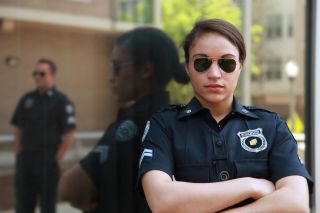Law and Crime
The Psychology of Police Deadly Force
Brain responses can boost the perception of threat in deadly force encounters.
Posted October 7, 2023 Reviewed by Gary Drevitch

Most cops don’t want to kill people, and most officers go their entire careers without firing their gun, but every officer knows he or she may someday have to make that choice.
Police have the state-sanctioned authority to order citizens to do things against their will, and citizens have an obligation to comply with lawful orders by police. Police also have the power to use physically coercive force, up to and including deadly force, against citizens, guided by a set of legal standards and their own judgment and discretion. Many citizens don’t understand this, and herein lies the potential for misunderstanding and confrontation.
Police Deadly Force: Facts and Stats
In daily police work, any use of force (breaking up a fight, making an arrest) is exceedingly uncommon, a little over 1 in 100 police-citizen encounters. The odds of a citizen being killed by a police officer are a minute fraction of that.
Police are attacked by citizens far more frequently than police act forcefully against citizens, and many officers hold their fire even when it would be legally justified to use deadly force. In that vein, the overwhelming number of police use-of-force incidents are deemed justified by both the officer’s Internal Affairs Department investigation and independent state government oversight.
Only when an officer is suspected of using excessive force may they be disciplined, terminated, civilly sued, or criminally prosecuted.
So, what exactly is excessive force? Basically, it’s any level of force that exceeds what is necessary to preserve life and safety and to contain the situation. Note that the severity of force used, up to and including deadly force, has nothing to do with whether the action constitutes a justified use of force. For example, an officer’s shooting and killing a huge, angry, armed, and aggressive assailant may be justified if no other options exist to prevent a lethal outcome. But an officer’s inflicting even a minor gratuitous slap, pinch, or noogie to an otherwise restrained or cooperative citizen is excessive because it wasn’t necessary for safety or containment.
In fact, the law does not require police officers to invariably utilize the absolute minimum force necessary in a given situation, because how could one instantaneously judge what “minimum” means in every conceivable circumstance? Rather, based on the 1989 U.S. Supreme Court decision in Graham v. Connor, the law requires only that the level of force used be objectively reasonable to control a deadly threat situation—based on the perception and judgment of “a reasonable officer at the scene.”
Deadly Force Psychology: Brain and Behavior
And there’s the rub. What turns that perception of a given police-citizen encounter into a deadly-force scenario characteristically involves a complex web of interacting cognitive, neurobiological, and situational factors that may not be obvious to those assessing the event after the fact. For example, it is unusual for a firefight or grappling match with a citizen to begin instantaneously. Almost always, there is a verbal, emotional, and behavioral buildup, an interactional dance that precedes the escalation to a forceful confrontation.
A century of neurocognitive research has shown that under emergency life-and-death circumstances, the human brain takes extraordinary measures to allow its owner to survive and, in the case of police officers, to assertively and lawfully respond to a deadly threat. Most officers who have been involved in an otherwise justified officer-involved shooting have described one or more alterations in perception, thinking, and behavior that occurred during the event. Most of these can be interpreted as the natural adaptive defensive reactions of a nervous system that is conserving energy and allocating perceptual and cognitive resources under extreme physical and emotional demands.
Common perceptual and cognitive distortions during a deadly force encounter may include alterations in time perception, with events seeming to speed up or slow down. Many officers report sensory hyperfocus—“tunnel vision” or “auditory exclusion”—in which they are sharply focused on one particular aspect of the visual field or set of sounds. Typically, it's the assailant’s weapon or voice that become the focus, while everything in the perceptual periphery may be blocked out.
The volume, intensity, or sharpness of perceptions may be blunted or enhanced; for example, gunshots muffled into faint pops, or nearby voices amplified, attenuated, or totally blanked out.
In many life-and-death situations, the brain self-protectively magnifies the perception of threat, and the effect of these cognitive and perceptual distortions may be to make an assailant appear closer, larger, faster, and more menacing than is later judged to be the case based on witness accounts and/or video recordings. When a use-of-force encounter is contested, this post hoc analysis may be used as “evidence” that an officer acted negligently or maliciously even as the officer was responding to the threat as they perceived it at the time, in line with the Supreme Court standard of a “reasonable officer at the scene.”
Complicating this kind of post-incident review is the fact that disturbances in memory itself commonly occur in emergency response situations, including police use-of-force incidents, because all of the brain’s attention is focused on preserving life at that moment, not necessarily recording a record of events for later review. The result may be impaired or distorted recall of particular events during the confrontation or even for part of the officer’s own actions.
For example, it is common for officers not to remember how many rounds they fired. Paradoxically, other aspects of the scene may be recalled with unusual clarity; these are known as “flashbulb memories," and are often associated with the experience of extreme danger. Because all memory is reconstructive, up to a third of deadly force cases may involve an officer’s account differing markedly from the reports of other observers at the scene or as seen on video images. In some of these cases, the officer may be mistakenly accused of deliberately lying or covering up their actions.
Are Some Citizens Singled Out for Use-of-Force Actions?
This is an important question that can’t be dismissed or simplified. But as a summary statement, although there are at least a few bigoted individuals in any profession, police as a whole do not single out minorities for especially harsh treatment, up to and including deadly force, except when there are specific behavioral indicators of suspicious or potentially dangerous behavior, as would be the case for any citizen. In fact, studies that measure electrophysiological brain responses to threatening stimuli in simulated shooting scenarios in police subjects (described in the references below) have found that neural systems involved in response inhibition are more strongly activated by experimentally presented images of minority citizens holding a weapon than images of white citizens doing the same. This implies that the study subjects are actually hesitating longer before firing at the minority images, as if their brains are struggling with the conflict of whether or not to take the simulated shot.
In clinical interviews and surveys with officers, a fair number have reported just such feelings of hesitation in these circumstances—some exerting this restraint for purely tactical reasons, but other times precisely out of concern about later accusations of excessive force or racial bias. Once things have escalated to the point when an officer is faced with the split-second decision to respond to a perceived deadly threat, the assailant’s color is largely irrelevant. (Bias is more likely to play a role in how the encounter begins in the first place, which will be the subject of a future post.)
Unlike cops in movies and on TV, real-life police officers and the agencies that employ them rarely take a deadly force episode lightly. Even after legally justified and administratively cleared shootings, some officers undergo a period of cognitive and emotional destabilization, including rumination, impaired sleep, and sometimes physical symptoms like headaches or stomach upset.
Virtually all recover within a few days and are ready to return to work, but many agencies mandate a post-critical incident psychological evaluation before returning an officer to duty, and many agencies try to provide additional mental health counseling where needed.
In the case of a contested deadly force incident, however, the seismic pressure on an officer accused of such misconduct can be intense, as he or she may face months, if not years, of multi-agency investigations, civil litigation, and criminal prosecution, as well as career dissolution, financial insecurity, media condemnation, and family disruption. Under these circumstances, special clinical and legal strategies mediated by qualified professionals may be essential to helping that officer maintain sanity and focus on a positive outcome.
Note: Information provided herein is for educational purposes and is not intended to provide individual clinical or forensic advice or opinions. Always consult with a qualified legal, medical, or mental health professional for such cases.
References
Miller, L. (2015). Why cops kill: The psychology of police deadly force encounters. Aggression and Violent Behavior, 22, 97-111. [Reprint available upon request]
Miller, L. (2020). The Psychology of Police Deadly Force Encounters: Science, Practice, and Policy. Charles C Thomas. [Available on Amazon.com].




